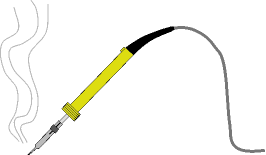

General: Types | Currents |
Functional model | Darlington pair
Switching: Introduction | Use relay? |
Chip output | for NPN | and PNP |
Sensors | Inverter
Next Page: Analogue and Digital Systems
Also See: Transistors (soldering, lead identification)
 | |
| Transistor circuit symbols | |
The leads are labelled base (B), collector (C) and emitter (E).
These terms refer to the internal operation of a transistor but they are not much
help in understanding how a transistor is used, so just treat them as labels!
A Darlington pair is two transistors connected together to give a very high current gain.
In addition to standard (bipolar junction) transistors, there are
field-effect transistors which are usually referred to as FETs.
They have different circuit symbols and properties and they are not (yet) covered by this page.
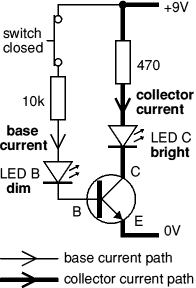 The diagram shows the two current paths through a transistor. You can build
this circuit with two standard 5mm red LEDs and any general purpose low power
NPN transistor (BC108, BC182 or BC548 for example).
The diagram shows the two current paths through a transistor. You can build
this circuit with two standard 5mm red LEDs and any general purpose low power
NPN transistor (BC108, BC182 or BC548 for example).
The small base current controls the larger collector current.
When the switch is closed a small current flows into the base (B) of the transistor. It is just enough to make LED B glow dimly. The transistor amplifies this small current to allow a larger current to flow through from its collector (C) to its emitter (E). This collector current is large enough to make LED C light brightly.
When the switch is open no base current flows, so the transistor switches off the collector current. Both LEDs are off.
A transistor amplifies current and can be used as a switch.
This arrangement where the emitter (E) is in the controlling circuit (base current)
and in the controlled circuit (collector current) is called common emitter mode.
It is the most widely used arrangement for transistors so it is the one to learn first.
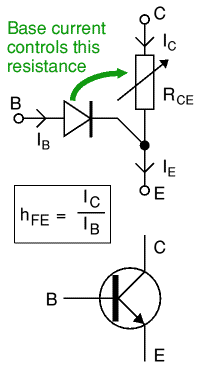 The operation of a transistor is difficult to explain and understand in terms of its internal structure.
It is more helpful to use this functional model:
The operation of a transistor is difficult to explain and understand in terms of its internal structure.
It is more helpful to use this functional model:
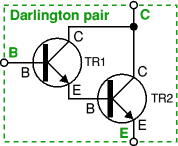 |
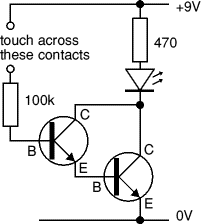 |
| Touch switch circuit |
Darlington pair current gain, hFE = hFE1 × hFE2
(hFE1 and hFE2 are the gains of the individual transistors)
This gives the Darlington pair a very high current gain, such as 10000, so that only a tiny base current is required to make the pair switch on.
A Darlington pair behaves like a single transistor with a very high current gain. It has three leads (B, C and E) which are equivalent to the leads of a standard individual transistor. To turn on there must be 0.7V across both the base-emitter junctions which are connected in series inside the Darlington pair, therefore it requires 1.4V to turn on.
Darlington pairs are available as complete packages but you can make up your own from two transistors; TR1 can be a low power type, but normally TR2 will need to be high power. The maximum collector current Ic(max) for the pair is the same as Ic(max) for TR2.
A Darlington pair is sufficiently sensitive to respond to the small current passed by
your skin and it can be used to make a touch-switch as shown in the diagram.
For this circuit which just lights an LED the two transistors can be any general
purpose low power transistors.
The 100k![]() resistor protects the transistors if the contacts are linked with a piece of wire.
resistor protects the transistors if the contacts are linked with a piece of wire.
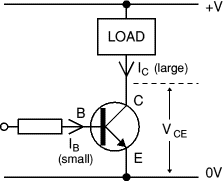 When a transistor is used as a switch it must be either OFF or fully ON.
In the fully ON state the voltage VCE across the transistor is almost zero
and the transistor is said to be saturated because it cannot pass any more
collector current Ic.
The output device switched by the transistor is usually called the 'load'.
When a transistor is used as a switch it must be either OFF or fully ON.
In the fully ON state the voltage VCE across the transistor is almost zero
and the transistor is said to be saturated because it cannot pass any more
collector current Ic.
The output device switched by the transistor is usually called the 'load'.
The power developed in a switching transistor is very small:
For information about the operation of a transistor please see the
functional model above.
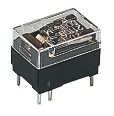 |
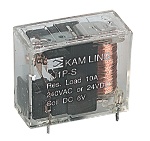 |
| Relays Photographs © Rapid Electronics |
Advantages of relays:
Disadvantages of relays:
A transistor can also be used to enable a chip connected to a low voltage supply (such as 5V) to switch the current for an output device with a separate higher voltage supply (such as 12V). The two power supplies must be linked, normally this is done by linking their 0V connections. In this case you should use an NPN transistor.
A resistor RB is required to limit the current flowing into the base of the transistor and prevent it being damaged. However, RB must be sufficiently low to ensure that the transistor is thoroughly saturated to prevent it overheating, this is particularly important if the transistor is switching a large current (> 100mA). A safe rule is to make the base current IB about five times larger than the value which should just saturate the transistor.
The procedure below explains how to choose a suitable switching transistor.
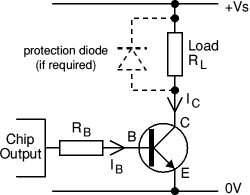
|
| NPN transistor switch (load is on when chip output is high) |
| load current Ic = | supply voltage Vs |
| load resistance RL |
| hFE(min) > 5 × | load current Ic |
| max. chip current |
| RB = | Vc × hFE | where Vc = chip supply voltage
(in a simple circuit with one supply this is Vs) |
| 5 × Ic |
For a simple circuit where the chip and the load share the same power supply (Vc = Vs) you may prefer to use: RB = 0.2 × RL × hFE
Then choose the nearest standard value for the base resistor.
Example
The output from a 4000 series CMOS chip is required to operate a relay with a
100![]() coil.
coil.
The supply voltage is 6V for both the chip and load. The chip can supply a maximum current of 5mA.
![]() .
so choose RB = 1k8 or 2k2.
.
so choose RB = 1k8 or 2k2.
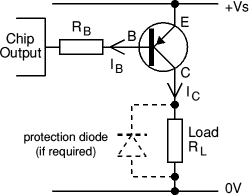
|
| PNP transistor switch (load is on when chip output is low) |
The procedure for choosing a suitable PNP transistor is exactly the same
as that for an NPN transistor described above.
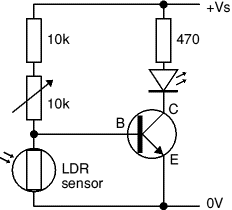 |
| LED lights when the LDR is dark |
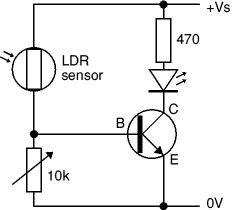 |
| LED lights when the LDR is bright |
The 10k![]() fixed resistor
protects the transistor from excessive base current (which will destroy it) when the variable
resistor is reduced to zero. To make this circuit switch at a suitable brightness you may
need to experiment with different values for the fixed resistor, but it must not be less than
1k
fixed resistor
protects the transistor from excessive base current (which will destroy it) when the variable
resistor is reduced to zero. To make this circuit switch at a suitable brightness you may
need to experiment with different values for the fixed resistor, but it must not be less than
1k![]() .
.
If the transistor is switching a load with a coil, such as a motor or relay, remember to add a protection diode across the load.
The switching action can be inverted, so the LED lights when the LDR is brightly lit, by swopping the LDR and variable resistor. In this case the fixed resistor can be omitted because the LDR resistance cannot be reduced to zero.
Note that the switching action of this circuit is not particularly good because there will be an intermediate brightness when the transistor will be partly on (not saturated). In this state the transistor is in danger of overheating unless it is switching a small current. There is no problem with the small LED current, but the larger current for a lamp, motor or relay is likely to cause overheating.
Other sensors, such as a thermistor, can be used with this circuit, but they may require a different variable resistor. You can calculate an approximate value for the variable resistor (Rv) by using a multimeter to find the minimum and maximum values of the sensor's resistance (Rmin and Rmax):
Variable resistor, Rv = square root of (Rmin × Rmax)
For example an LDR: Rmin =
100![]() , Rmax =
1M
, Rmax =
1M![]() , so Rv =
square root of (100 × 1M)
= 10k
, so Rv =
square root of (100 × 1M)
= 10k![]() .
.
You can make a much better switching circuit with sensors connected to a suitable
IC (chip). The switching action will be much sharper with no partly on state.
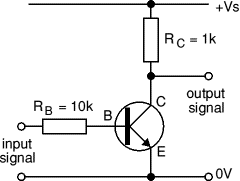 Inverters (NOT gates) are available on logic chips but if you only require one
inverter it is usually better to use this circuit. The output signal (voltage)
is the inverse of the input signal:
Inverters (NOT gates) are available on logic chips but if you only require one
inverter it is usually better to use this circuit. The output signal (voltage)
is the inverse of the input signal:
If you are connecting the inverter to a CMOS logic chip input (very high impedance)
you can increase RB to
100k![]() and RC to 10k
and RC to 10k![]() ,
this will reduce the current used by the inverter.
,
this will reduce the current used by the inverter.
